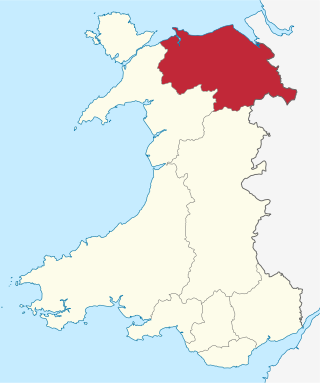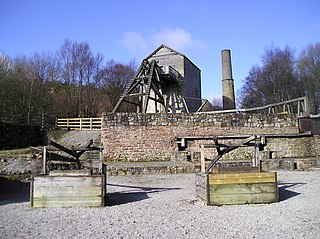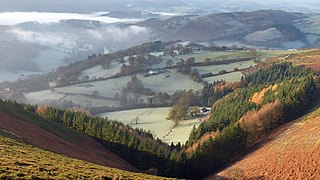
Clwyd is a preserved county of Wales, situated in the north-east corner of the country; it is named after the River Clwyd, which runs through the area. To the north lies the Irish Sea, with the English ceremonial counties of Cheshire to the east and Shropshire to the south-east. Powys and Gwynedd lie to the south and west respectively. Clwyd also shares a maritime boundary with Merseyside along the River Dee. Between 1974 and 1996, a slightly different area had a county council, with local government functions shared with six district councils. In 1996, Clwyd was abolished, and the new principal areas of Conwy County Borough, Denbighshire, Flintshire and Wrexham County Borough were created; under this reorganisation, "Clwyd" became a preserved county, with the name being retained for certain ceremonial functions.
Dorset Wildlife Trust (DWT) is a wildlife trust covering the county of Dorset, United Kingdom. The trust was founded in 1961 as Dorset Naturalists' Trust, to protect and conserve the wildlife and natural habitats of the county.

Durham Wildlife Trust is a registered charity that was established in 1971, originally as the Durham County Conservation Trust, becoming Durham Wildlife Trust in 1988. The Trust operates across the area of the old County Durham, which includes Darlington, Gateshead, South Tyneside and Sunderland.

The Minera Limeworks were extensive lime quarries and kilns at Minera in Wrexham, Wales. It was located at grid reference SJ253520, near the villages of Gwynfryn, Minera, and Coedpoeth and was locally referred to as The Calch.
The Wrexham and Minera Railway or Wrexham and Minera Branch was a railway line in North Wales between the city of Wrexham, the village of Brymbo where it served the Brymbo Steelworks, and the lead mines and limeworks at Minera. A further branch ran from Brymbo to Coed Talon, where it connected with lines to Mold. The system was constructed in several stages between 1844 and 1872, while the various lines making up the system closed in 1952, 1972 and 1982.

The Minera Lead Mines were a mining operation and are now a country park and tourist centre in the village of Minera near Wrexham, in Wrexham County Borough, Wales.

Butterfly Conservation (BC) is a UK-wide nonprofit environmentalist organization and charity dedicated to conserving butterflies, moths, and the environment. The charity uses its research to provide advice on how to conserve and restore butterfly and moth habitats and it runs projects to protect more than 100 threatened species of Lepidoptera. Butterfly Conservation is also involved in conserving hundreds of sites and reserves for butterflies and moths throughout the UK.

Coed Talon is a small, formerly industrial village between Leeswood and Treuddyn in Flintshire, Wales. Its name is derived from the Welsh word coed ("wood") and the word talwrn, anglicised to "Talon", meaning a "hillside devoid of trees" or "threshing-floor". Other translations of "Talwrn" suggest the words "lumber", "spot" or "field".
The city of Wrexham has two main city parks, these being Bellevue Park and Acton Park. On the outskirts of the city there is also open parkland on and surrounding the Erddig estate. There is also a city centre green and various smaller parks and open spaces.
Brecknock Wildlife Trust is a former wildlife trust covering the vice county of Brecknockshire in Wales. The Trust was founded in 1964, with a network of volunteers carrying out most of its work. No full-time conservation officers were in post until 1987. Heritage Lottery funding helped the Trust to expand and a bequest of £1,000,000 in 2003 resulted in the appointment of a Reserves Officer. In April 2018 it merged with The Wildlife Trust of South and West Wales.

Cors Goch National Nature Reserve is principally a fen in a shallow valley near the village of Llanbedrgoch, on the eastern side of Anglesey. The site is managed by the North Wales Wildlife Trust and also includes calcareous heath, meadow and an acid heath overlain on millstone grit. There is some area of open water including Llyn Cadarn but much is marsh or shallow bog which supports a species rich ecosystem dominated by reeds. A number of rare plants and animals are able to flourish in this environment, including great crested newt and adders. The medicinal leech and glow worm have also been found here. The site is managed by the North Wales Wildlife Trust.
Gwent Wildlife Trust (GWT) is a wildlife trust covering the area between the lower Wye and Rhymney rivers which forms the vice county of Monmouthshire in south-east Wales. It is a registered charity and a member of the Wildlife Trusts Partnership.
Esclusham Mountain is an area in Wrexham County Borough, Wales, United Kingdom, and is part of the Ruabon Moors. It rises to a height of 460 m, with the nearby spur of Cyrn-y-Brain, to the west, reaching 473 m. It lies mostly within the community of Esclusham. A smaller spur to the north, known as Minera Mountain, is within the neighbouring community of Minera.

Llanfair-Mathafarn-Eithaf is a parish and community in Anglesey, Wales including the small seaside town of Benllech. The community population taken at the 2011 census was 3,382.

The Clwydian Range and Dee Valley is a designated Area of Outstanding Natural Beauty (AONB) located in north-east Wales, covering the Clwydian Range, and the valley of the River Dee.

Big Pool Wood is a Nature reserve located near Gronant, Flintshire, Wales. The site is part of the Dee Estuary SSSI & SAC due to the unique wildlife and organisms found in the area. The reserve is centered around a pond which paths and boardwalks encircling it. There are a number of bird hides located around the reserve.












